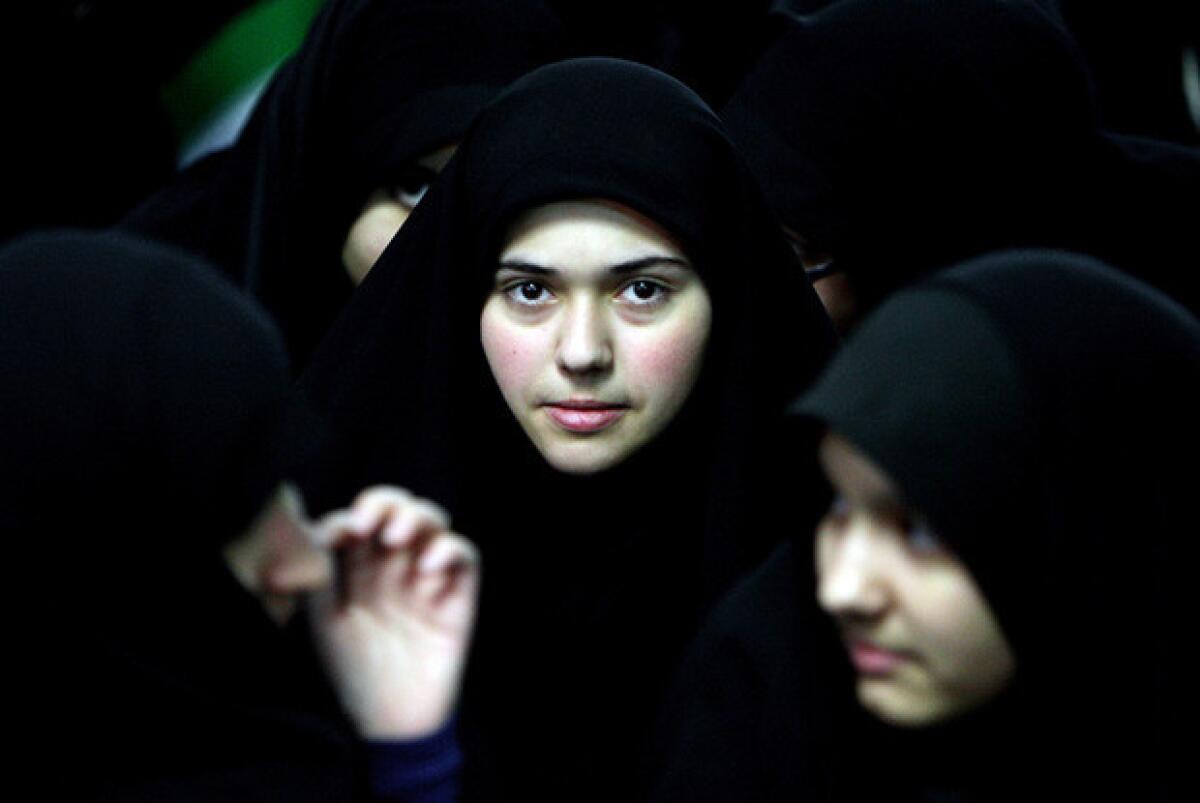Philippines birth control: Filipinos want it, priests don’t
In the Philippines, access to contraceptives is limited for the most part to those with the means to pay. The Catholic Church has fought a “reproductive health bill” in the legislature that would change that.
- Share via
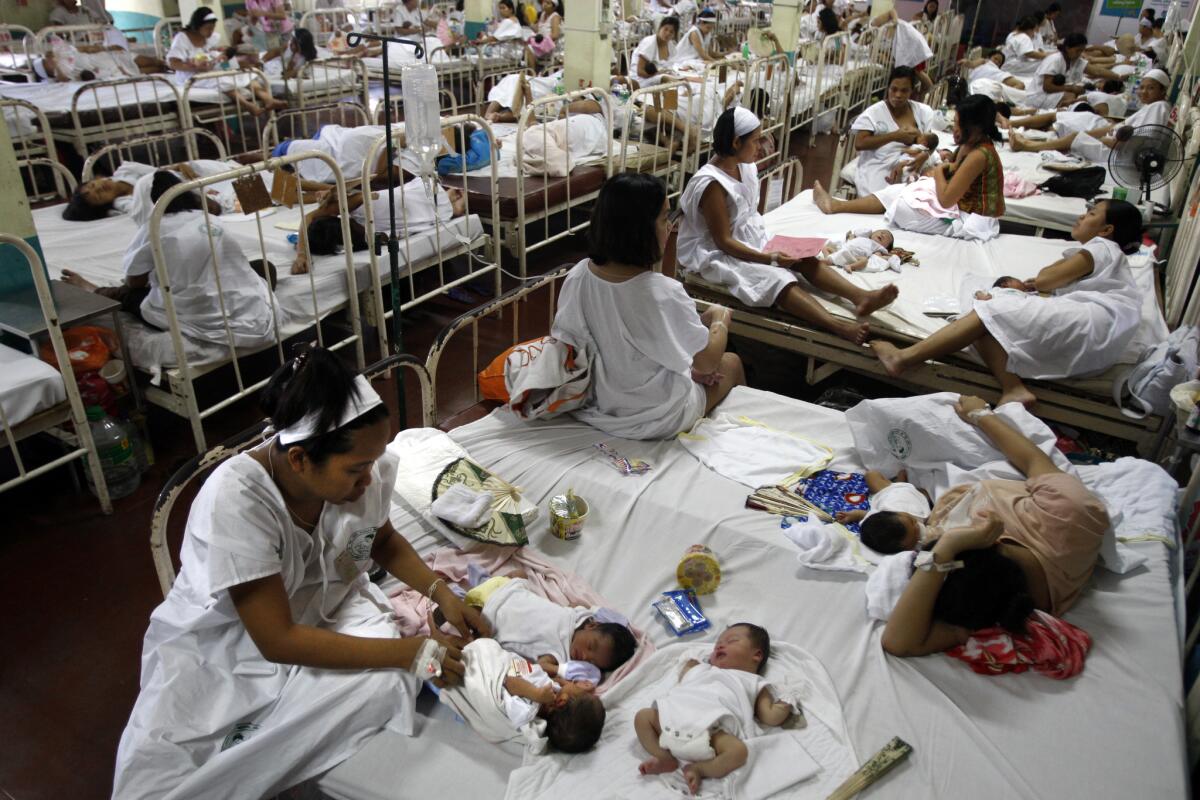
Even in the quiet season, women must share beds in the postnatal recovery room at Jose Fabella hospital.
Women share beds after giving birth at Dr. Jose Fabella Memorial Hospital in Manila. The Philippine capital is one of the most densely populated places on Earth. A ban on contraception at public clinics there has put birth control out of the reach of most of the city's poor. (Rick Loomis / Los Angeles Times) More photos
July 22, 2012
Last of five parts
Shortly after sunrise, a woman with soulful eyes and short-cropped black hair hurried down a narrow alley in flip-flops, picking her way around clusters of squatting children, piles of trash and chunks of concrete.
Yolanda Naz's daily scramble had begun. Peddling small shampoo packets in the shantytown of San Andres, she raced to earn enough money to feed her eight children.
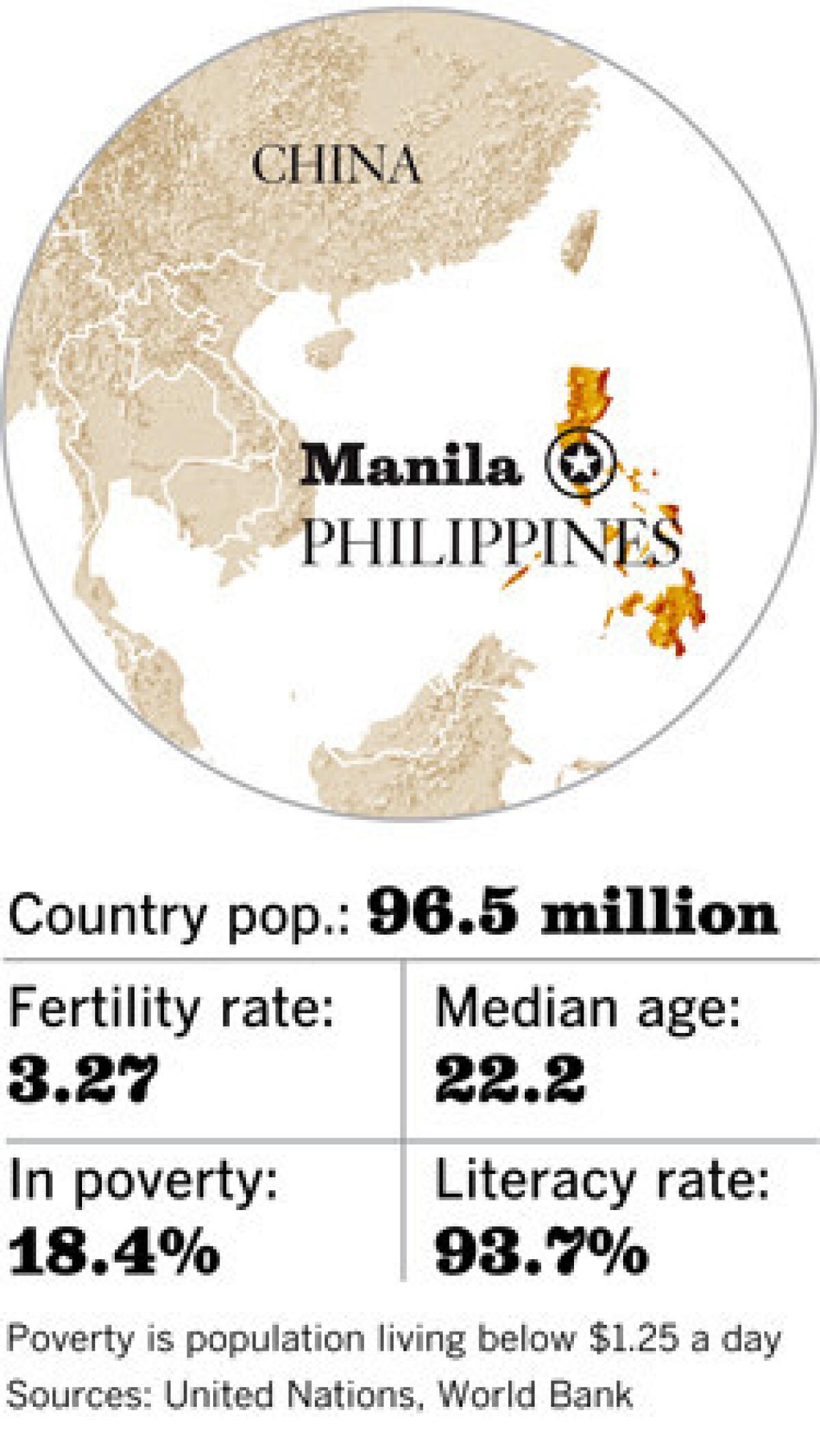
She went door to door in the sweltering heat, charming and cajoling neighbors into parting with a few pesos. After several hours, she had scrounged enough to buy a kilo of rice, a few eggs and a cup of tiny shrimp.
"My husband and I skip lunch if there is no money," Naz said as she dished rice and shrimp sauce into eight plastic bowls in the 10-by-12-foot room where the family eats and sleeps.
This was not the life Naz wanted. She and her husband, who sells coconut drinks from a pushcart, agreed early in their marriage to stop at three children. Though a devout Catholic, she took birth control pills in defiance of priests' instructions at Sunday Mass.
But after her third child was born, the mayor of Manila — with the blessing of Roman Catholic bishops — halted the distribution of contraceptives at public clinics to promote "a culture of life." The order put birth control pills and other contraceptives out of reach for millions of poor Filipinos, who could not afford to buy them at private pharmacies.
"For us, the banning of the pills was ugly," Naz said. "We were the ones who suffered."
At 36, she had more children than teeth, common for poor women after repeated pregnancies and breast-feeding.
Undernourished and living in close quarters, her children were often sick. Measles was sweeping through the shantytown, afflicting two of Naz's sons and her 3-year-old daughter, Jasmine, who hung like a rag doll from her mother's arms.
"I pray to God. I pray really, really hard," she said. "Should God decide to take my kids, just don't let them suffer."
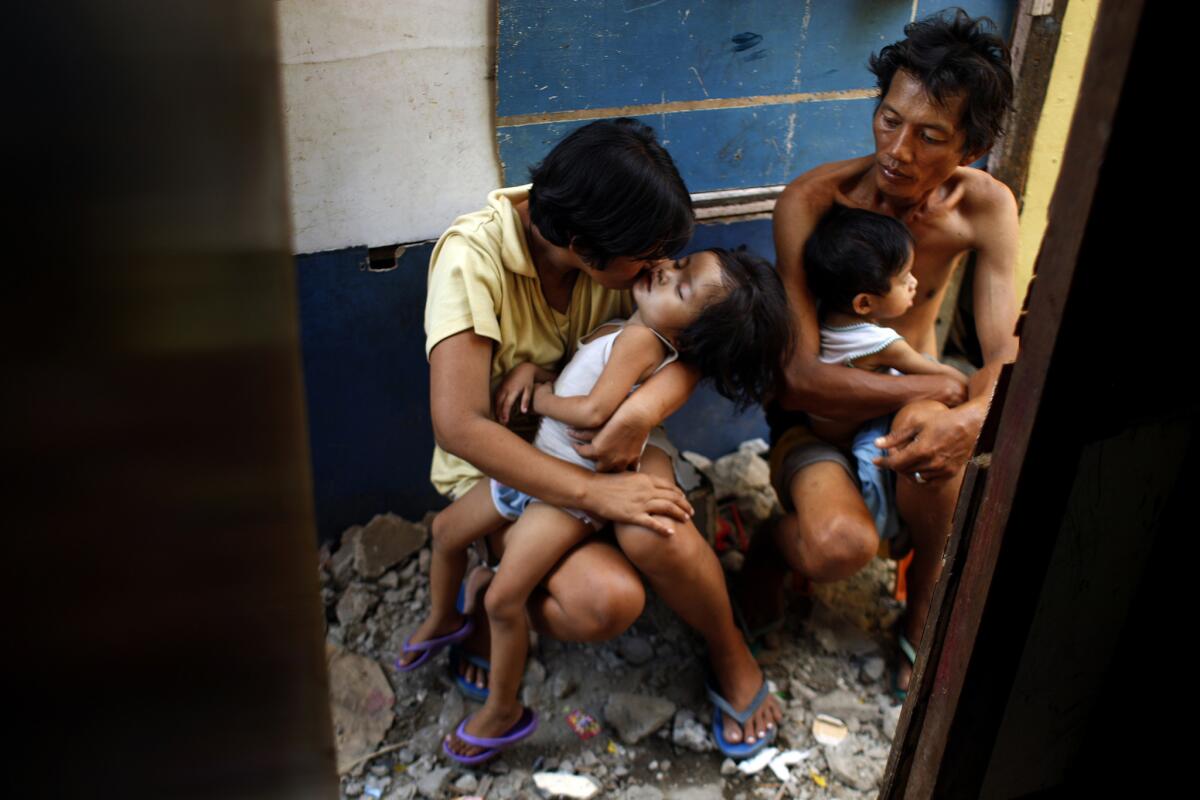
Yolanda and Noel sit in the alley outside their shack with two of their children. They scramble each day to get the money to feed the family. Although she is a Roman Catholic, Yolanda disagrees with the church's opposition to contraception and is part of a lawsuit challenging the city ban on providing birth control at public clinics. (Rick Loomis / Los Angeles Times) More photos
In the Philippines, a country of 96 million people, access to birth control is mostly limited to those with the means to buy it. A "reproductive health bill" in the national legislature seeks to change that: It calls for public education about contraceptives and government subsidies to make them available to everyone.
The church and like-minded opponents have stalled the legislation for 14 years. Following Vatican dictates, Philippine bishops oppose any "artificial" measures to prevent pregnancy, sanctioning only natural means such as periodic abstention from sex.
It's one example of how religious and political forces affect women's control over childbearing and, as a result, the trajectory of population growth in the developing world.
The church's stance puts it at odds with many of its followers in the Philippines. Eight out of 10 Filipinos are Catholic. Even for weekday Mass, popular churches draw huge crowds that tie up Manila traffic.
Polls show, however, that 70% of the population supports the reproductive health bill, which also calls for sex education in schools.
Birth control is a source of political dispute in many societies, including the United States. In the Philippines, however, the battle has been particularly acrimonious because of the church's wide reach and influence.
Priests denounce the reproductive health bill during Mass. Some churches post billboards with gruesome images of aborted fetuses and the message "NO to Reproductive Health Bill — YES to the Gospel of Life."
Lawmakers say the church threatens to deny them Communion if they vote for the legislation.
In 2010, Benigno Aquino III was elected president after pledging to sign the bill. Bishop Nereo Odchimar, then president of the Catholic Bishops Conference of the Philippines, suggested Aquino might be excommunicated if he followed through on the commitment.
Neither man's resolve has been tested: After years of debate, a consensus version of the law has yet to emerge from the Philippine Congress and reach the president's desk.
For nearly four decades, the U.S. Agency for International Development was the major donor of contraceptives to the Philippines, spending about $400 million total. The administration of George W. Bush phased out the program in 2008, saying it was time for the Philippine government to take full responsibility.
Then-President Gloria Macapagal Arroyo refused, deferring to bishops who had supported her election. She acknowledged taking birth control pills as a young mother but said she had since sought forgiveness from a priest.
"The contraceptive pills do not only prevent conception, they even destroy conception once it is already there," retired Archbishop Oscar V. Cruz said in an interview. "That is abortion."
Since U.S. funding ended, affordable contraceptives have become scarce, particularly in Manila. A patchwork of programs funded mainly by foreign donors provides limited access for the poor.
According to a 2008 government survey, 39% of married Philippine women in their childbearing years said they wanted to avoid or postpone pregnancy but were not using modern contraceptives. By far, the most commonly cited reason was fear of side effects. Other reasons included a husband's opposition, cost and lack of availability.
Half of all pregnancies in the Philippines are unintended, the survey found.
A similar pattern holds across the developing world, where an estimated 222 million women want to avoid pregnancy but do not use modern birth control.
If they did, unplanned births in those countries would fall by two-thirds, as would the number of abortions, according to an analysis by the U.N. Population Fund and the Guttmacher Institute, a New York think tank that supports access to contraception and safe abortion.
First what I do is to pray to God and ask for forgiveness. I'm telling God I'm not charging a big amount.”— Erlinda A. Casitas, who performs illegal abortions
Under that scenario, the global population would keep rising but more slowly.
The Philippines has one of the fastest-growing populations in Asia. It is on track to increase by more than half, to 155 million, by 2050.
Greater Manila is one of the most densely populated places on Earth. About a third of its 12 million inhabitants live in poverty, many in teeming shantytowns that sprawl across trash dumps and cemeteries.
Still, former Manila Mayor Jose "Lito" Atienza, who ordered the removal of contraceptives from public clinics a dozen years ago, said he sees economic potential in a growing population.
"Our people are so talented and so skilled and brilliant and bright," he said, citing Manila's entrepreneurial street vendors and the 10 million Filipinos working overseas who boost the economy by sending money home.
"When you have more people, you have a bigger labor force. You have a bigger social security base. You have more productivity. You have more consumption. More production. The whole cycle of the economy moves faster."
Atienza said he also opposes birth control because he believes it "weakens the family" and is in conflict with the Filipino Constitution's protection of the unborn.
"Government should not spend government funds for this purpose," he said.
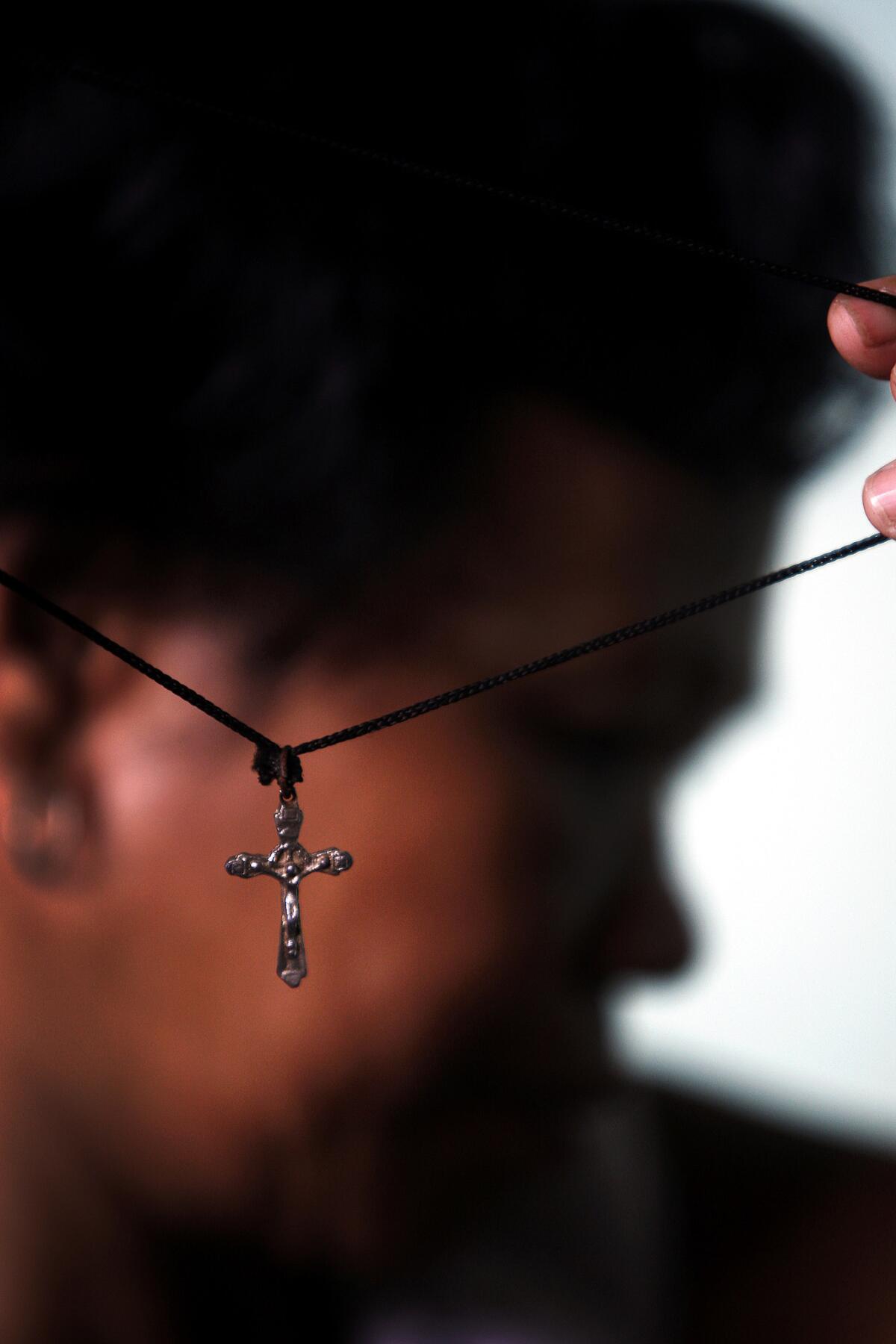
Erlinda A. Casitas, a practicing Catholic, is also a hilot, one of the massage abortionists who perform a large share of the estimated 475,000 illegal abortions in the Philippines every year. (Rick Loomis / Los Angeles Times) More photos
Erlinda A. Casitas presses her thick thumbs into her thigh to demonstrate how she dislodges a fetus and massages it out of the womb.
"I usually feel for the baby, for the swelling, and then I apply pressure gradually downwards," said Casitas, a middle-aged woman with wide-set eyes. "I'm very careful. If I apply too much pressure, the patient will experience shock or the woman will get bruises."
Abortion is a crime in the Philippines, unless a board of medical professionals deems it necessary to save the mother's life.
Casitas is a hilot, one of the massage abortionists who perform a large share of the estimated 475,000 illegal abortions in the country every year. Before she gives the aggressive massage, Casitas has her clients take three tablets of Cytotec, an ulcer medication sold on the black market and used to bring on uterine contractions.
Many women seeking abortions go to the area around Quiapo Church, in old downtown, where street vendors sell crucifixes and statues of the Virgin Mary, alongside bitter herbal brews such as "Pampa Regla" (which means "induce menstruation" in Tagalog) to end pregnancy. Cytotec is on sale, too, but kept out of sight.
"Everyone knows about Quiapo," Casitas said.
Among her clients, she said, are "mothers who have many kids, who can no longer afford to have more children," and mothers with children under a year old who want "birth spacing."
Casitas said she doesn't have a fixed fee. She often asks patients for a $20 donation, less if they are very poor.
"First what I do is to pray to God and ask for forgiveness," said Casitas, a practicing Catholic who wears a small silver crucifix around her neck. "I'm telling God I'm not charging a big amount…. It's just like helping the patient with her problem."
"I think God hears my prayers because so far I haven't had any patient who suffered any hemorrhage and has to be rushed to the hospital."
Casitas said she quizzes clients on why they got pregnant. "I advise the women to use pills, injectables [hormones] or IUDs."
She knows many will not follow her advice, or cannot afford to. But she said she has a strict rule: "I only allow myself to help a woman twice. So when she comes to me to abort her first pregnancy, I do it. If she comes back to me a second time, I do it. The third time, I refuse."
When illegal abortions go awry, the patients often end up at Dr. Jose Fabella Memorial Hospital in Manila, the largest women's hospital in the Philippines.
On a spring day in one ward, injured women lay on cots, one beside the other. One patient was moaning and barely conscious, her blood splattered at the base of the bed. She'd been rushed there, delirious from fever and infection. Her skin was ashen from losing a third of her blood.
She was 28, an upholsterer's wife with four children. Pregnant again, she was three months along when she tried to abort the fetus by drinking a bitter herbal brew.
Some hospitals in the Philippines refuse treatment in such cases and call the police because staff members see the women as criminals and sinners, according to doctors and nurses at Jose Fabella.
Here, doctors say they ask few questions and treat the injured. Cleaning up botched abortions, however, is the second order of business at Jose Fabella.
No. 1 is childbirth and keeping children alive.
More than 17,000 babies a year are born at the hospital — the nation's busiest — inspiring its nickname, "Baby Factory."
In the delivery room that day, teams of doctors and nurses had their hands full with two births in progress. A half-dozen women in various stages of labor waited on gurneys.
In the hallway, wheels clacked across the white tile floor. A gurney burst into the delivery room led by a nurse holding a newborn in outstretched hands. A coiled umbilical cord connected the blue-tinged baby to a woman lying on her back, hair matted.
She had just arrived by cab. The newborn girl couldn't wait.
Dr. Maria Lu Andal moved in to clear the baby's airways and snip the cord. The baby began to cry, turning bright pink as a crew of assistants swarmed mother and child, swabbing, draping, measuring and tagging.
In a room nearby, newborns lay shoulder to shoulder on tables for nurses to weigh and measure. Oversize recovery rooms contained rows of worn metal beds, each shared by two mothers and their newborns.
In the neonatal unit, 68 babies lay in incubators, many of them dangerously premature. On average, about a third die, doctors said.
Andal, in dark green scrubs, a hairnet and mask, recalled that she once delivered 36 babies in a four-hour shift.
"It's like an assembly line," said Dr. Ruben Flores, who directs the hospital and its 1,200 employees. "It never stops."
This was the quiet season. Only 63 babies were delivered this day, about half the hospital's capacity.
"That's what they say: It's a baby factory," Flores said. "But I say, we didn't produce the babies. We just deliver them. These babies were produced at home."
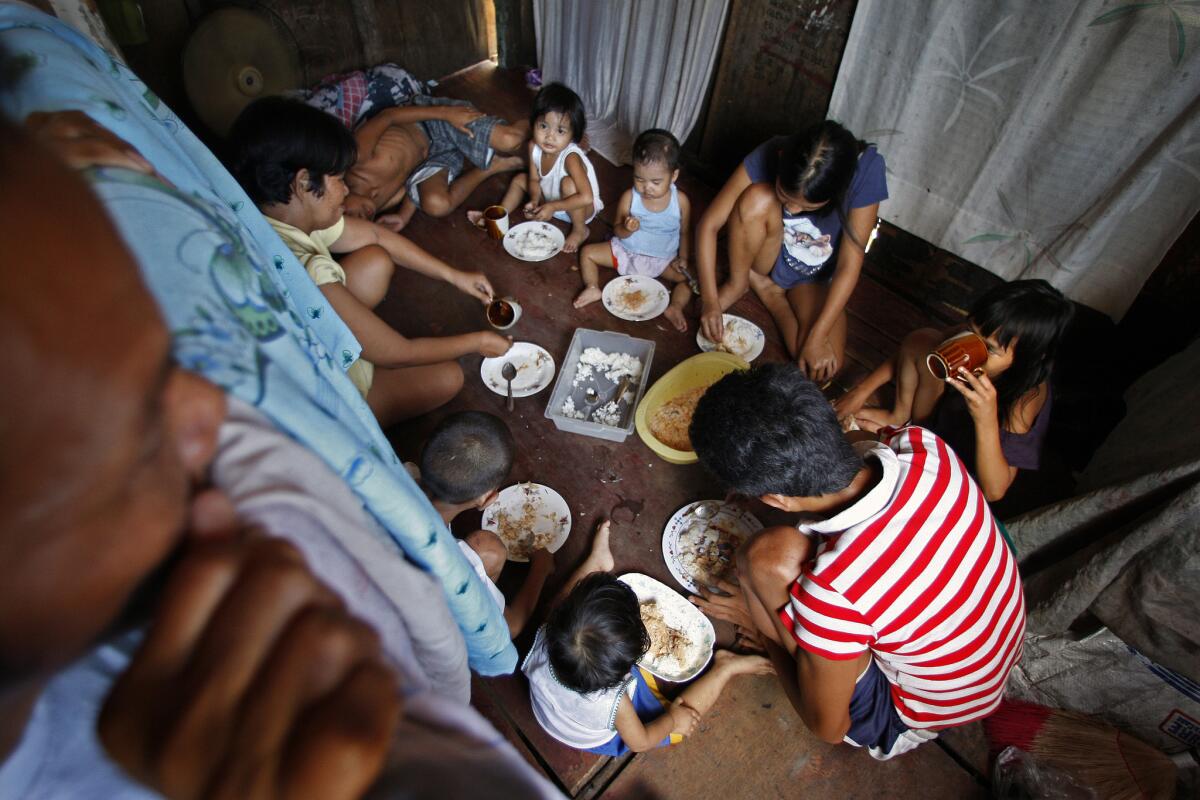
The Naz family gathers for a meal, in the same room where everyone sleeps. When food is especially scarce, only the children eat. About a third of Manila's residents live in poverty. (Rick Loomis / Los Angeles Times) More photos
Yolanda Naz began to stack up the plastic bowls and plates from the midday meal. Her family had devoured every morsel.
A boy came to the door with an orange garden hose. For a few pesos, Naz can fill a plastic barrel with water for cooking, cleaning and bathing.
Naz picked through the remaining coins from her shampoo sales to see if there was enough for the next meal.
On a good day, her husband, Noel, earned about $5 selling coconut drinks from his cart. That was enough to pay for rice, instant noodles, some eggs, vegetables, even some milk and a diaper for the baby. But Noel is afflicted with a racking cough that often keeps him from working.
Naz sometimes buries her pride and asks neighbors for a loan of 10 cents or a bit of food.
A few years ago, one of her neighbors asked her to join a lawsuit by women's rights groups seeking to overturn Manila's ban on contraceptives at public clinics. She became a plaintiff, along with 19 other poor residents of the capital.
These women and a few of their husbands are asking the court to grant them access to birth control pills, condoms and IUDs, a rare challenge to church authority.
The case has been thrown out twice, once by the Philippine Supreme Court because it lacked a signature from one of the 20 plaintiffs. It was refiled in a lower court, where it has been essentially frozen for three years.
Naz said she'll always be a Catholic. That doesn't mean she agrees with the priests on everything.
"When I go to Mass, I hear the priest give sermons saying that pills are bad," Naz said. "But whenever I hear that, I just say to myself that for me, it's not evil, it's not bad or it's not sinful.
"What is more sinful is to have more children than I can afford to feed."
About the series
Los Angeles Times staff writer Kenneth R. Weiss and staff photographer Rick Loomis traveled across Africa and Asia to document the causes and consequences of rapid population growth. They visited Kenya, Uganda, China, the Philippines, India, Afghanistan and other countries.
Sign up for Essential California
The most important California stories and recommendations in your inbox every morning.
You may occasionally receive promotional content from the Los Angeles Times.

